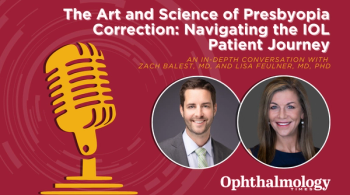
Travoprost with less toxic preservative causes less ocular surface toxicity
An anti-glaucomatous medication formulated with a less toxic preservation causes less ocular surface toxicity, according to one cornea specialist. The development of travoprost ophthalmic solution 0.004% (Travatan Z, Alcon Laboratories), a prostaglandin analogue preserved with a new ionic-buffered preservative system (sofZia, Alcon Laboratories), seems to be the direction in which pharmaceutical companies will be moving in the future to eliminate harmful side effects caused by chronic application of anti-glaucoma medications.
Key Points
"The prostaglandin analogues are the most commonly used agents for treating glaucoma in the United States and worldwide," said Dr. Asbell, professor of ophthalmology, Mt. Sinai School of Medicine, New York. "Those drugs, and most ophthalmic therapeutic agents, are preserved typically with benzalkonium chloride [BAK], because when a multi-use bottle is used, the risk of inadvertent contamination is decreased. However, there is a great deal of evidence that chronic application of drugs containing BAK is toxic to the ocular surface, primarily the corneal and the conjunctival epithelial cells."
The result of this chronic application is dry eye syndrome with epitheliopathy and chronic irritation, she said.
As a result of those problems, interest exists in developing ophthalmic medications that contain either a less toxic preservative or no preservative, according to Dr. Asbell.
"The transition from the use of the well-established prostaglandin analogue travoprost containing BAK to travoprost with a less toxic preservative is addressing those issues," she said.
In the study under discussion, Dr. Asbell and co-author Seth Epstein, PhD, assistant professor of ophthalmology, Mt. Sinai School of Medicine, evaluated travoprost with and without BAK to determine the effects on the ocular surface in a tissue culture model. Corneal epithelial cells and human conjunctival cells were grown separately in tissue culture, the drugs were applied, and the results stained to determine the viability of the cells resulting from application of the drugs.
"As we expected, travoprost without BAK was much less toxic compared with travoprost with BAK," Dr. Asbell said. "There are data from other studies indicating that travoprost with and without BAK is efficacious in lowering IOP. [Travoprost] seems like a natural choice because it causes fewer highly undesirable side effects that are so common with medications preserved with BAK."
She underscored the importance of less toxic preservatives. In her cornea practice, Dr. Asbell said, she treats patients who chronically administer more than one glaucoma medication or those who were at high risk at the onset, i.e., patients with pre-existing dry eye.
"Those patients present with serious epitheliopathy and considerable pain and loss of vision," she said. "In my practice, I see that slice of patients with glaucoma who are particularly bothered by the side effects induced by all their glaucoma medications. When all things are equal, it is logical to prescribe a less toxic drug for those patients.
"[Travoprost] is the beginning of the wave in terms of ophthalmic pharmaceutical companies looking at ways of formulating appropriate medications with less risk of toxicity from the preservative," she added. "There are a number of ways to approach that, but specifically by using preservatives that are less toxic or using containers with a collapsible internal sleeve that facilitates multiple use and preserves sterility without a preservative."
According to Dr. Asbell, the latter option is not yet approved in the United States for ophthalmic drugs, except for an artificial tears formulation.
"[Travoprost] is appropriately on the right track and is a good start in looking at improving treatment by eliminating some of the bothersome and potentially harmful side effects that may interfere with patient compliance," she concluded.
Newsletter
Don’t miss out—get Ophthalmology Times updates on the latest clinical advancements and expert interviews, straight to your inbox.
















































.png)


